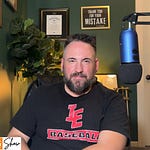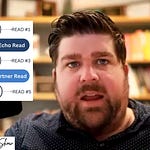Sean Morrisey is a former school psychologist, and has been an upper elementary teacher for nearly 20 years.
Full Transcript:
Justin Baeder (00:00):
Welcome everyone to the Teaching Show. I’m your host Justin Baeder, and I’m honored to welcome to the program Sean Morrisey. Sean, welcome to the Teaching Show. Thank you.
Sean Morrisey (00:09):
Glad to be here.
Justin Baeder (00:10):
So Sean, I’ve been following you for quite a while on Twitter or X and have been really impressed with the kinds of things that you share around vocabulary and morphology. So tell us a little bit about yourself and then let’s get into it.
Sean Morrisey (00:23):
Yeah, so I’m a fifth grade teacher. I’m a former school psychologist as well. So I worked in that field for about 10 years, but I’ve been teaching for almost 20 years now. First, fourth and fifth grades, mostly fifth and outside of Buffalo, New York.
Justin Baeder (00:37):
Good deal. And there are some things that you do with vocabulary with upper elementary students that seem to get quite a bit of response online, quite a bit of interest. Talk to us about your approach to teaching vocabulary and morphology.
Sean Morrisey (00:51):
Yeah, I think my approach is just trying to scale up more than what’s typically done. I think when we think about knowledge, vocabulary is a big part of knowledge. Vocabulary is a big part of reading comprehension. I mean, I think some experts say you can’t really even tease apart what’s reading comprehension and what’s really just vocabulary. So I try to just embed it in my day all throughout the day. I think one of the big things for the past couple years, I’ve been doing a lot more morphology work in ELA, and we’re talking about not just ELA, but we’re talking science and social as well. So when we’re thinking about scaling up words, just in general, the root NOV meaning new, you could kind of scale up and teach kids while using a morphology matrix where you have NOV and like a suffix, so, so you have words like novice or you have renovate or innovate and kind of always linking those words back to the base. The root nav meaning new, I think it really scales up how many words kids can learn at one time. For sure. This
Justin Baeder (02:03):
Sounds familiar in a sense that I’ve been aware for a long time of the concept of root words and prefixes and suffixes take us into some of the additional dimensions of morphology. I feel like I have some things to learn there that maybe weren’t part of the conventional thinking on Latin roots, Greek roots, prefixes, suffixes.
Sean Morrisey (02:24):
Yeah, I think it might be kind of the structure, how you’re presenting. So I am a fan of Pete Bower’s work. So when he puts roots, prefixes and suffix in a matrix, and it’s hard to visualize, we’re just talking about it, but I’ll just do a simple one, like the root tracked, meaning to kind of drag or pull, you could put that kind of in a middle of a diagram, and on the left hand side you could put all of the prefixes that you can build with the root track, and then you could put the suffixes as well. So one of my favorite words is to teach is contract, or sometimes we pronounce it contract depending on the context. So you’re teaching the prefix there in the matrix, meaning together and track meaning pull. So you can be contracting muscles, muscles are pulling together or contracting an illness, or even contract, two parties are being pulled together to sign something.
(03:25):
So it gives, people are saying morphology ties everything together now. I think it really does, for sure. And then I think it’s thinking about science and social. How can we get kids to remember things in those core areas more we silo, especially the secondary level, we just teach social studies or science and we’re not really teaching the language as much as we probably could. Even a root like side, CIDE, meaning kill genocide. I just taught a unit on the Holocaust in World War II in fifth grade, and genocide is a word that comes up throughout middle and high school and social studies. So just going back, oh, then kids are like, oh, herbicide and then homicide, and thinking about it in that way, I think it really gives kids, kids an anchor and they won’t forget it as much, for sure.
Justin Baeder (04:33):
Yeah, and I think much teaching with a knowledge rich curriculum across multiple subject areas, it gives kids the sense that there’s coherence here, that how to spell a word is not entirely random. And I think for a lot of our struggling learners, they just feel like everything is random. I don’t know. I feel like there’s not any sense of coherence to it, but you’re giving ‘em a structure to make sense of spelling. And English is of course a fairly irregular language, but there are a lot of patterns to it still. And you’re explicitly teaching vocabulary and morphology as part of your school day, is that right?
Sean Morrisey (05:07):
Yeah, so it’s honestly throughout the school day, I have a certain time in my day where it kind of gets lumped together. I’m working on actually my own curriculum where morphology, academic vocabulary, fluency, spelling, it’s not all siloed, it’s all taught together. So we only have so much instructional time. So when we decide to teach something, there’s a huge opportunity cost, and I think we need to be teaching what has the best chance of kids actually learning it. Morphology impacts spelling greatly. I’m a true believer you have to start with phonetics. You have to start with, even in fifth grade for my fifth graders, we’ll segment words by syllables. But when we talk about prefixes and suffixes, morphology is so important to the word congregate, Greg, meaning the root greg, meaning flock, meaning together like congregate, and then spelling congregation, you’re just adding another suffix to congregate. So spelling wise, when you’re really thinking about and teaching the suffixes, especially morphologies, very, very helpful for a lot of kids. It really makes it stick, for sure.
Justin Baeder (06:27):
Well, Sean, if people want to find you online, maybe learn more about the writing and the resources that you put out. Where’s the best place for them to go?
Sean Morrisey (06:36):
Yeah, I guess mean the only social media I’m on is on X, so @SMorrisey, so that’s where you can find, I like to post a lot. I think teachers want to see, we have so much research and we talk back and forth and it’s all kind of this conceptual stuff, but teachers really want to see how are we applying that research into everyday classrooms. So that’s where I just like to post a lot, Hey, this is what I did today. And I think with doing that, teachers very, very happy with that. So I’ve gotten a lot of positive feedback.
Justin Baeder (07:13):
Yeah, I think it’s some of the best content out there because we’re seeing into your classroom, we’re seeing your actual things that you’re doing with your students and what you’re getting back from them. So really appreciate you doing that and putting in the work to share that with the world. So thank you and keep it up.
Sean Morrisey (07:30):
Thanks.









